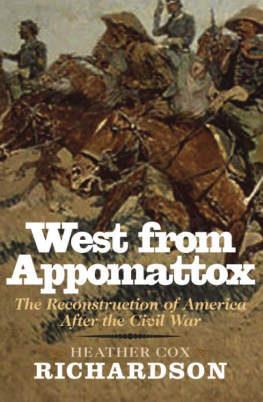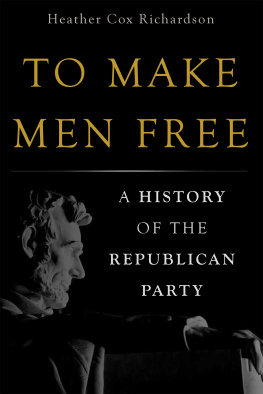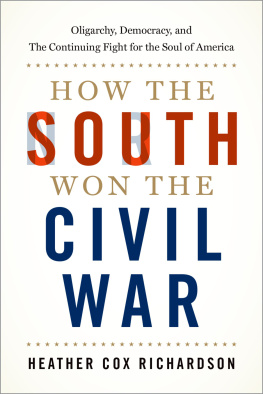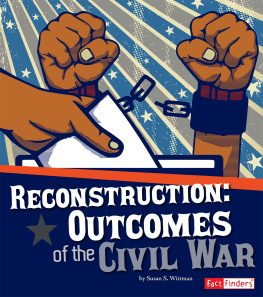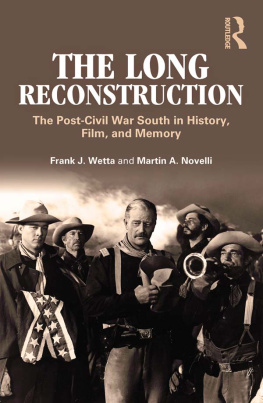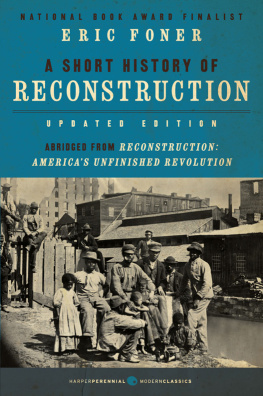W EST FROM A PPOMATTOX
West from
Appomattox
The Reconstruction of
America after the Civil War
H EATHER C OX R ICHARDSON

Yale University Press New Haven & London
Published with assistance from the Mary Cady Tew Memorial Fund.
Photo on p. iii: Rough Rider on bucking horse, Long Island, New York. Theodore Roosevelt Collection, Harvard College Library.
Copyright 2007 by Heather Cox Richardson.
All rights reserved.
This book may not be reproduced, in whole or in part, including illustrations, in any form (beyond that copying permitted by Sections 107 and 108 of the U.S. Copyright Law and except by reviewers for the public press), without written permission from the publishers.
Designed by James J. Johnson and set in Adobe Caslon by Keystone Typesetting, Inc.
Printed in the United States of America.
Library of Congress-Cataloging-in-Publication Data
Richardson, Heather Cox.
West from Appomattox: the reconstruction of America after the Civil War / Heather Cox Richardson.
p. cm.
Includes bibliographical references and index.
ISBN : 978-0-300-11052-4 (cloth : alk. paper)
1. United StatesPolitics and government18651900. 2. Reconstruction (U.S. history, 18651877) 3. United StatesHistory18651898Biography. 4. National characteristics, American. 5. Political cultureUnited StatesHistory19th century. 6. Middle classUnited StatesPolitical activity History19th century. 7. United StatesSocial conditions18651918. I. Title.
E 661. R 53 2007
973.8dc22
2006024633
A catalogue record for this book is available from the British Library.
The paper in this book meets the guidelines for permanence and durability of the Committee on Production Guidelines for Book Longevity of the Council on Library Resources.
10 9 8 7 6 5 4 3 2 1
For David Herbert Donald and William E. Gienapp
Acknowledgments
At a time when I was disenchanted with academia and almost ready to quit the profession, a colleague urged me to give it another try, insisting that no people were as generous as scholars. I was skeptical, but the last few years have proved him right. Colleagues and friends have nurtured this book from the time of my first e-mail to Jim Huston, asking if the project sounded workable, to the arrival of the final manuscript draft, which Eric Arnesen took time to edit days before he left for a semester abroad. Much of what is good in this book is thanks to the wonderful people who helped along the way; all the faults that remain are my own responsibility.
Special thanks are due to those who reviewed the final manuscript, whose detailed comments improved the final product immensely. They are Eric Arnesen, Thomas J. Brown, James West Davidson, Michael Green, Mitchell Snay, and Mark Summers.
So many other nineteenth-century historians have asked or answered questions, commented on drafts, or discussed pieces of this book with me that thanking them by name runs the risk of seeming to try to hide behind other peoples reputations. Instead, I will thank as generally as possible people directly in my field, hoping that individuals recognize themselves where reviewers wont. Various colleagues at Columbia University, Kansas State University, Louisiana State University, Oklahoma State University, Princeton University, the University of Arkansas, the University of Florida, and the University of Pennsylvania have been insightful critics of this project. At my home university, BL has been a frequent source of support and information. Scholars at the Southern Intellectual History Circle gave an early version of this manuscript careful criticism that helped it mature; thanks are especially due to BWB and DMH. The scholars whom the Institute for Southern Studies invited to talk about recent trends in reconstruction historiography offiered an insightful discussion of the state of reconstruction studies; I thank them for our stimulating debate.
Scholars outside of reconstruction history have also contributed to this project. Henry Bolter, Jonathan Hansen, Daniel Kryder, Geo? Tegnell, Andrea Walsh, Michael Willrich, and Richard Young, with whom I worked for a number of years on the Teaching American History grant project, Defining Justice, will see their influence here. At UMass Amherst, womens historian Laura Lovett and Latin Americanist Jane Rauch offiered advice and translations and generously produced documents I couldnt find myself. Also at UMass, classicist Carlin Barton explained the importance of moderation to Roman society so lucidly she made me approach my American moderates more sympathetically; and political scientist Michael T. Hannahan ran a critical eye over material on a moments notice.
This book also benefited enormously from students at MIT, Suffolk University, and UMass Amherst. It was sparked in 2001 when an MIT student challenged me to explain why the image of the cowboy has come to represent America. As my ideas developed, I tried them out on students at Suffolk University and UMass Amherst, who were most helpful in identifying weaknesses and applauding strengths. On more than one occasion, I have rewritten sectionsand in one case a whole chapterwhen student responses indicated I had organized material badly. I thank all of you and hope you learned as much from me as I did from you.
A number of people outside academia have lent their expertise to this project. Engineer Klint Rose figured out whether or not an arrow really could go through a bison. Dr. Charles A. Garabedian explained obscure medical issues and made some guesses about what really killed Theodore Roosevelts wife. Bill Klein at Sandy Lake Implement Company in Pennsylvania explained spring tooth harrows. Guy Crosby of Vermont showed me an army worm moth and impressed on me the devastation the worms had wreaked on his fields.
Others worked to bring this book to fruition. My agent, Lisa Adams, helped me to whip the idea into a workable project. Lara Heimert, then at Yale University Press, recognized the potential of my ideas and gave me the space to develop them. PJ, FW, and PB provided writing tutorials when I couldnt make my material fit together. Stalwart editor Chris Rogers cut my prose in a mainstream way, and copy editor Eliza Childs did a brilliant job of making the manuscript both grammatically correct and readable. Finally, Margaret Otzel managed the books final stages with both professionalism and humor. I thank them all.
There are also personal debts to be acknowledged when a book is finished. Mitchell Snay has always been at the other end of a telephone or an e-mail as we both struggled to write books that threatened sometimes to devour us. Jo Calnan, Ann Corcoran, Beth LaDow, Jim and Sarah Matel, Gillian Pearson, Karina Pinella, and Mary Jean and Walther T. Weylman cheered this project on, read drafts, provided information, lent books, and asked questions. Devon, Jillian, and Rachel Murphy kept an eye on my children, playing capture the flag and drawing pictures with endless patience. Robert, Marshall, and Eva made my work easier by their comforting acceptance of a mother who kept disappearing with a pen and a manuscript; on a more practical level, their concrete approach to history has taught me to keep my prose from straying into theoretical tangents. Michael R. Pontrelli pretended to believe me when I assured him that this one would be a small project. I thank him for managing to refrain (mostly) from saying I told you so when it grew into an all-consuming big book, for taking the kids on weekend trips so I could work, and for keeping the book (and me) balanced.
Finally, I owe profound thanks to the two men to whom this book is dedicated. David Herbert Donald and William E. Gienapp were unstinting in their effiorts to train me to be a historian and then supported me no matter what happened. I owe them more than any book can ever repay.
Next page
